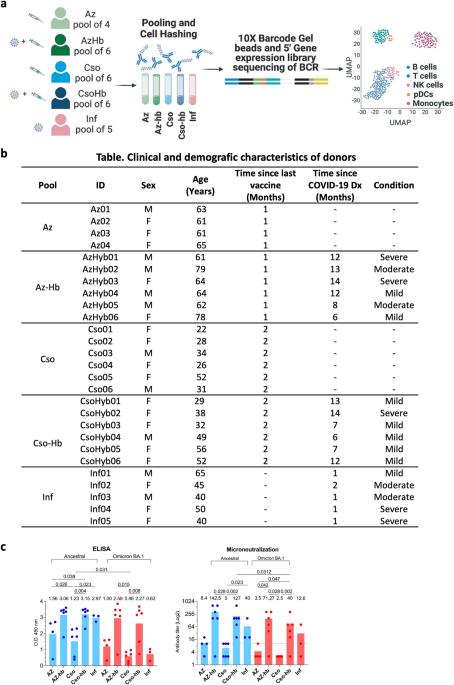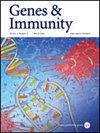基于腺病毒载体的 COVID-19 疫苗诱导的混合免疫的单细胞转录组比较图谱
IF 4.5
3区 医学
Q1 GENETICS & HEREDITY
引用次数: 0
摘要
本研究对五组不同人群的外周血单核细胞进行了抗体反应和单细胞RNA-seq分析,这五组人群分别是:接种AZD1222(AZ)或Ad5-nCoV(Cso)疫苗的天真受试者、曾感染AZD1222(AZ-hb)或Ad5-nCoV(Cso-hb)并随后接种(混合)疫苗的受试者,以及曾感染COVID-19并已康复的受试者(Inf)。结果显示,AZ诱导的中和抗体反应比Cso更强。单细胞 RNA 数据显示,Cso 和 Cso-hb 中记忆 B 细胞的频率很高。相比之下,AZ和AZ-hb组中表达CXCR4的活化幼稚B细胞比例最高。对 CD4+ 和 CD8+ T 细胞的转录组分析表明,接种疫苗、混合免疫或自然感染后会产生不同的反应。然而,单剂量的Ad5-nCoV足以强烈激活表达ANX1和FOS的CD4+ T细胞(幼稚和记忆),这与AZ观察到的混合反应类似。一个有趣的发现是,Cso-hb 组中表达 GZMB、GZMH 和 IFNG 基因的 CD8+ T 细胞亚群被强力激活。我们的研究结果表明,两种疫苗都能有效刺激细胞免疫反应;但是,Ad5-nCoV能在先前感染的个体中诱导出更强的CD8+ T细胞反应。本文章由计算机程序翻译,如有差异,请以英文原文为准。

Comparative single-cell transcriptomic profile of hybrid immunity induced by adenovirus vector-based COVID-19 vaccines
In this study, antibody response and a single-cell RNA-seq analysis were conducted on peripheral blood mononuclear cells from five different groups: naïve subjects vaccinated with AZD1222 (AZ) or Ad5-nCoV (Cso), individuals previously infected and later vaccinated (hybrid) with AZD1222 (AZ-hb) or Ad5-nCoV (Cso-hb), and those who were infected and had recovered from COVID-19 (Inf). The results showed that AZ induced more robust neutralizing antibody responses than Cso. The single-cell RNA data revealed a high frequency of memory B cells in the Cso and Cso-hb. In contrast, AZ and AZ-hb groups exhibited the highest proportion of activated naïve B cells expressing CXCR4. Transcriptomic analysis of CD4+ and CD8+ T cells demonstrated a heterogeneous response following vaccination, hybrid immunity, or natural infection. However, a single dose of Ad5-nCoV was sufficient to strongly activate CD4+ T cells (naïve and memory) expressing ANX1 and FOS, similar to the hybrid response observed with AZ. An interesting finding was the robust activation of a subset of CD8+ T cells expressing GZMB, GZMH, and IFNG genes in the Cso-hb group. Our findings suggest that both vaccines effectively stimulated the cellular immune response; however, the Ad5-nCoV induced a more robust CD8+ T-cell response in previously infected individuals.
求助全文
通过发布文献求助,成功后即可免费获取论文全文。
去求助
来源期刊

Genes and immunity
医学-免疫学
CiteScore
8.90
自引率
4.00%
发文量
28
审稿时长
6-12 weeks
期刊介绍:
Genes & Immunity emphasizes studies investigating how genetic, genomic and functional variations affect immune cells and the immune system, and associated processes in the regulation of health and disease. It further highlights articles on the transcriptional and posttranslational control of gene products involved in signaling pathways regulating immune cells, and protective and destructive immune responses.
 求助内容:
求助内容: 应助结果提醒方式:
应助结果提醒方式:


